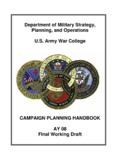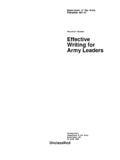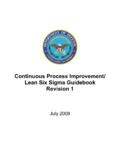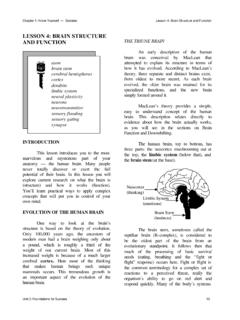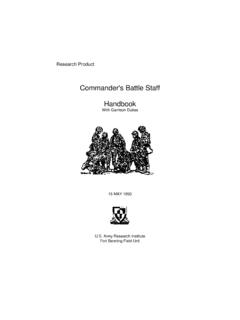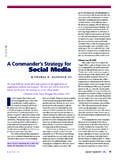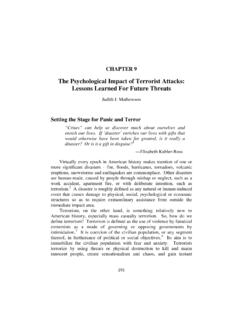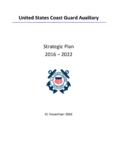Transcription of Moral Reasoning as a Strategic Leader …
1 Moral Reasoning as a Strategic Leader competency Martin L. Cook Professor of Ethics, US Army War College The transition from organizational leadership to truly Strategic leadership involves the development and enhancement of new skills and abilities. The relative clarity of missions, goals, and strategies required for effective leadership at the direct and organizational levels require one set of skills. There, the tasks are well-defined, as are the standards of performance. The Leader is required to master and display those skills within that well-defined framework. In contrast, the VUCA (volatile, uncertain, complex and ambiguous) character of the issues and the environment at the Strategic level evoke and demand new competencies and skills for successful leadership at that level. One can no longer assume what the central problem really is, let alone how it should best be handled. The Strategic Leader lives and works in a much more complex social and political environment than the direct or organizational Leader .
2 At those lower levels, the Leader s place in a single hierarchy is usually quite clear; at the Strategic level, one works with peers, and leads as much by building consensus as by issuing commands. Clearly, skills that may have made for excellent leadership at those lower levels may no longer serve as one advances to Strategic leadership . Among those new skills required at the Strategic level is advanced ability in Moral Reasoning . Just as new demands are placed on the Strategic Leader in the areas of interpersonal skills, critical thinking, intellectual creativity and flexibility (to name only a few), the Strategic environment also places new and different requirements on the Moral Reasoning skills of the Strategic Leader . In ways analogous to those other areas, Moral Reasoning operates at various levels and Moral issues arise at new levels of complexity. Modes of dealing with ethical issues which have served an individual well at some levels of leadership will become inadequate as that individual begins to function in more complex and unstructured environments.
3 For the direct Leader of troops, it may be adequate if one maintains one s integrity and tells the truth. And, more importantly, it may be perfectly clear in most or all circumstances which courses of action are morally right in the more defined areas or direct and even organizational leadership . In the more complex and multifaceted environment of Strategic leadership , in contrast, Moral decision making is far more complex. The constraints, demands and expectations of Strategic leaders bring multi-dimensional pressures to bear that require abilities in Moral Reasoning far more demanding than those required in less complex environments. In such environments, the Moral challenges take on a fundamentally different character than in simpler operational assignments. Where, for example, is the line between the flexibility and pragmatism required for good Strategic leadership and unacceptable Moral compromise of fundamental principles?
4 How do we distinguish between the morally justified and required incomplete disclosure of information to superiors, subordinates and political leadership and simple lying and deceit? Clearly, the Moral issues characteristic of this level of Strategic leadership require a sophistication and nuance in Moral thinking that simple slogans like maintain your integrity and always tell the truth do little to advance. Just as the transition to 2strategic leadership requires growth in other dimensions of personal skills, so too in the Moral arena, new skills and abilities are required in the dimension of Moral reflection and analysis. Moral development is often thought to be an inherently diffuse subject, not susceptible to objective discussion and analysis. Throughout this century, however, any number of dimensions of human development have been subjected to careful empirical study and analysis.
5 Jean Piaget, for example, was able through close study of children to develop an account of normal human development of cognitive skills. James Fowler has studied the development of religious thinking in a similar way and developed a pattern of normal faith development. Similarly, Lawrence Kohlberg and his successors have analyzed the patterns of normal human development in the area of morality and ethical thinking. They have developed the Kohlberg Scale of Moral development and social scientific instruments such as the Defining Issues Test that allow empirical assessment of an individual s level of Moral thinking. This scale allows empirical determination of the level of an individual s degree to Moral thinking on a six-point scale, based on the Reasoning pattern they exhibit as they think their way through set Moral problems. For future Strategic leaders , it is important to recognize these various levels of Moral development and to assess where in this scale their own Moral thinking may fall.
6 In the following discussion, I will describe the outline of Kohlberg s scale as a vehicle for our seminar discussion of Moral thinking as a Strategic Leader competency . Kohlberg divides Moral development into three levels, each of which has two stages, generating a total of six stages. Each is distinguished by the central theme or idea the individual uses to make a determination of Moral rightness or wrongness. The scale is developmental in the sense that human beings tend as they mature to advance up the scale (most adults cease development somewhere in Level Two, just as most adults cease development short of the highest levels of cognitive or other developmental scales). The outline of the model is as follows: Level One: Preconventional Stage One: Reward and Punishment Stage Two: Instrumental Level Two: Conventional Stage Three: Peer group Stage Four: Societal Expectation Level Three: Post-Conventional Stage Five: Social Contract Stage Six: Universal Moral Principle The pivot of the scale is conventional Moral thinking.
7 This kind of Moral thinking is central, not only in the sense that it lies in the middle of the scale, but also in the sense that most adults function at this level and approach Moral issues in terms of this kind of thinking. By conventional, Kohlberg means Moral thinking that conforms to the norms and styles of thinking typical of the individual s environment and peer group. In other words, confronted with a Moral issue or question, the conventional Moral thinker resolves it by appealing to the taken-for-granted Moral assumptions and beliefs of his 3peer group (stage three), or the generalized Moral assumptions of the society in which she lives (stage four). For example, consider the question whether a given social practice or arrangement is morally acceptable or not. The conventional thinker will approach the question with the assumption that those practices which are accepted in his or her society are valid, simply because the conventions of the social group approve of them.
8 In other words, the conventional thinker will lack the ability to think outside of the Moral assumptions of the group or society around her. It is helpful to think about this level in terms of one s own memories of growing up, and one s observations of children. Toddlers and preschoolers are very clear in their orientation toward reward and punishment and their concern with authority figures. Teenagers are notorious for their orientation toward approval of their peers and their tendency to follow the crowd, even in behavior they have been taught is wrong and foolish. And many adults clearly behave and think in highly conventional terms of their society, finding it hard or impossible to stand out and question or challenge the Moral assumptions of their society. But to return to the discussion of the scale itself: children, and some poorly socialized adults, do not think about Moral issues even in terms of convention.
9 For such pre-conventional Moral thinkers, Moral choices are governed solely with reference to themselves and their personal welfare. At the lowest level, stage one, those things are wrong which will be punished by authority figures in that person s life. For example, for a toddler, the concern with being chastised or punished by a parent is the determining factor in judging their behavior. Similarly, right is what parents or other authorities approve, and behavior that conforms to the direction of those authorities is judged to be good behavior. A slightly higher but still pre-conventional mode of Moral Reasoning occurs at stage two. At this level, the individual assesses actions by asking whether a course of action will or will not advance individual interests. In other words, actions are assessed instrumentally -- in terms of whether they bring about outcomes the individual desires.
10 Think of the ways parents persuade children to be good by promising that if they are, they ll receive a special reward or opportunity to do something they really want. The lowest level of conventional thinking emerges as a child matures and recognition dawns that there are Moral rules to be followed and principles to be respected, even at the cost to personal preference and desires. For the stage three thinker, those Moral principles are those approved by one s peer group, friends and communities. Perhaps the clearest example of this level of thinking is the typical middle-schooler, for whom standing apart from the peer group is virtually inconceivable. But the demands of the group may or may not always give the individual what he or she really wants. The expectations of the group have come to take on a life and authority of their own, and may override the individual s personal wants and needs.
